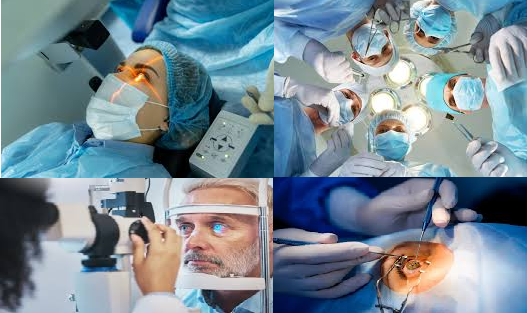Cataract surgery is a common and effective medical procedure to remove cataracts, which are cloudy formations that develop on the eye's natural lens, impairing vision. During cataract surgery, the cloudy lens is replaced with an artificial intraocular lens (IOL) to restore clear vision. It is one of the most frequently performed surgeries worldwide and has a high success rate, significantly enhancing patients' quality of life.
Difference Between Types of Cataract Surgery
The two primary types of cataract surgery are Phacoemulsification and Extracapsular Cataract Extraction (ECCE). Both methods have the same goal—to remove the cloudy lens and replace it with an artificial one—but they differ in the techniques used:- Phacoemulsification (Phaco): This is the most common technique, involving a small incision and an ultrasound device that breaks up the cataract, which is then suctioned out. The artificial lens is inserted through the small incision, which often heals on its own without stitches.
- Extracapsular Cataract Extraction (ECCE): This technique involves a larger incision through which the entire lens is removed in one piece. This method is typically reserved for cases where the cataract is too dense for phacoemulsification. ECCE requires sutures and a longer recovery time.
What are the Two Types of Cataract Surgery?
As noted above, the two primary types of cataract surgery are:- Phacoemulsification (Phaco): Involves small incisions and ultrasound energy to emulsify the lens.
- Extracapsular Cataract Extraction (ECCE): Involves a larger incision to remove the lens in one piece.
How is a Cataract Operation Done?
The procedure typically follows these steps:- Preparation: The eye is numbed with anesthetic eye drops, and the area is cleansed. Sometimes a mild sedative is given to help the patient relax.
- Incision: A tiny incision is made on the cornea to allow access to the lens.
- Lens Removal: In phacoemulsification, an ultrasound probe is used to break up the cataract, which is then gently suctioned out. For ECCE, a larger incision is made, and the cataract is removed in one piece.
- Lens Implantation: An artificial lens (IOL) is inserted through the incision and positioned where the natural lens used to be.
- Closure: In most phacoemulsification surgeries, the incision is small enough that it does not require stitches, while ECCE may require sutures.
Who Invented Modern Cataract Surgery?
Modern cataract surgery, particularly the development of Phacoemulsification, is credited to Dr. Charles D. Kelman, an American ophthalmologist who revolutionized cataract surgery in the 1960s. His innovative technique involved using ultrasound to break up the cataract, making surgery less invasive, safer, and more accessible. The development of phacoemulsification dramatically reduced recovery times and paved the way for the current standard in cataract surgery.Cataract Surgery Machine
Cataract surgery machines play a crucial role in the phacoemulsification process. These machines are equipped with an ultrasound probe that vibrates at high speeds to break up the cloudy lens into tiny fragments. This probe simultaneously emulsifies and vacuums out the fragments while maintaining intraocular pressure, providing precise and controlled cataract removal. Modern cataract surgery machines are also equipped with advanced settings to ensure safety and reduce surgery time.KPE Eye Surgery
KPE stands for Keratoplasty Endothelial, a type of corneal transplant surgery. It is a form of lamellar corneal surgery, where only the damaged layers of the cornea are replaced rather than the full thickness. While KPE is different from cataract surgery, it’s sometimes performed alongside cataract surgery if the cornea has significant issues that impact vision.Small Incision Cataract Surgery
Small incision cataract surgery (SICS) is a technique similar to phacoemulsification but does not require phacoemulsification machines. The procedure involves creating a small self-sealing incision through which the cataract is manually removed. SICS is an economical and effective option, especially in areas with limited access to advanced phaco machines. It has a faster recovery than ECCE but may not be as minimally invasive as phacoemulsification.Read more :
1= https://dapachecker.co.uk/what-number-is-1302710452/
2= https://dapachecker.co.uk/what-is-the-meaning-of-number/
3= https://dapachecker.co.uk/what-is-cataract-surgery/
4= https://dapachecker.co.uk/what-is-the-history-of-dorsten/
